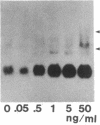Abstract
1 alpha,25-Dihydroxyvitamin D3 [1 alpha,25(OH)2D3], a hormonally active form of vitamin D3, has been shown to modulate cell differentiation and tumor promotion. This report demonstrates that mRNA of the metallothionein (MT) gene was induced by 1 alpha,25(OH)2D3 in cultured epidermal keratinocytes and also in liver, kidney, and skin tissues when 1 alpha-hydroxyvitamin D3, a synthetic precursor of 1 alpha,25(OH)2D3, was applied in vivo. Exposure of FRSK cells, a cell line derived from fetal rat skin keratinocytes, to 1 alpha,25(OH)2D3 at 5 ng/ml (12 nM) increased MT mRNA to almost the same extent as that induced by 10 microM dexamethasone or 1 microM CdCl2. This increase in the level of MT mRNA was evident within 2 hr and was maximal 12-24 hr after the addition of 1 alpha,25(OH)2D3. The induction was dose-dependent with concentrations of 1 alpha,25(OH)2D3 from 0.05 to 5.0 ng/ml. Amounts of MT increased with the increase of MT mRNA induced by 1 alpha,25(OH)2D3. Of the derivatives of vitamin D3 tested, only 1 alpha,25(OH)2D3 caused marked induction. Treatment with cycloheximide did not inhibit MT mRNA induction by 1 alpha,25(OH)2D3. 1 alpha,25(OH)2D3 induced MT mRNA in primary cultures of mouse epidermal keratinocytes but not in IAR-20, a liver cell line. 1 alpha,25(OH)2D3 had a similar effect in vivo: oral administration of 1 alpha-hydroxyvitamin D3 to mice resulted in increased levels of MT mRNA in the liver, kidney, and skin 24 hr later. Increase in the level of MT mRNA may be relevant to some biological actions of 1 alpha,25(OH)2D3.
Full text
PDF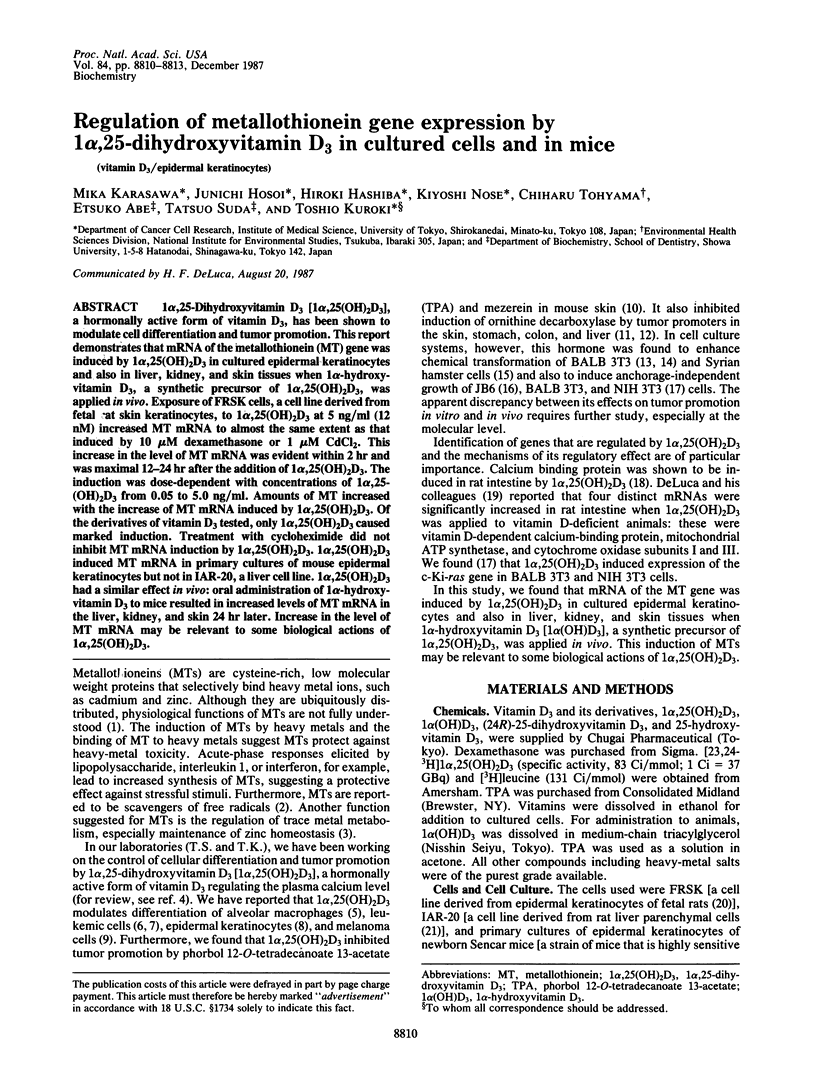
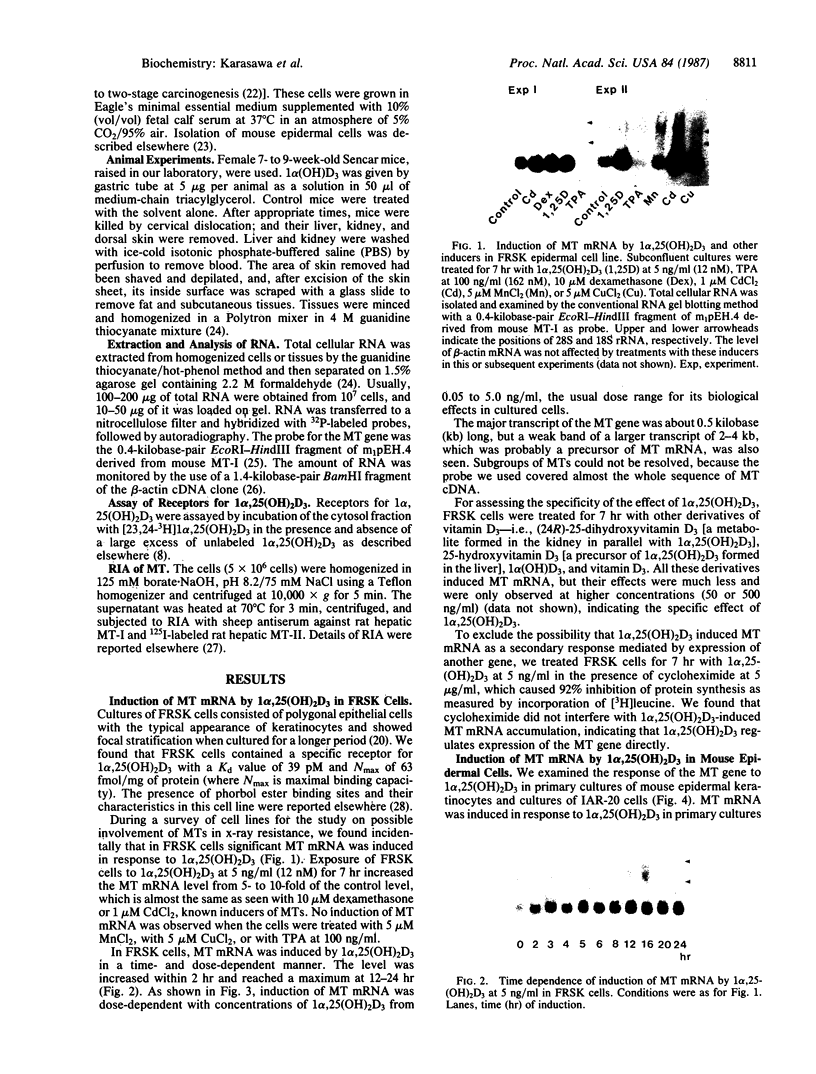
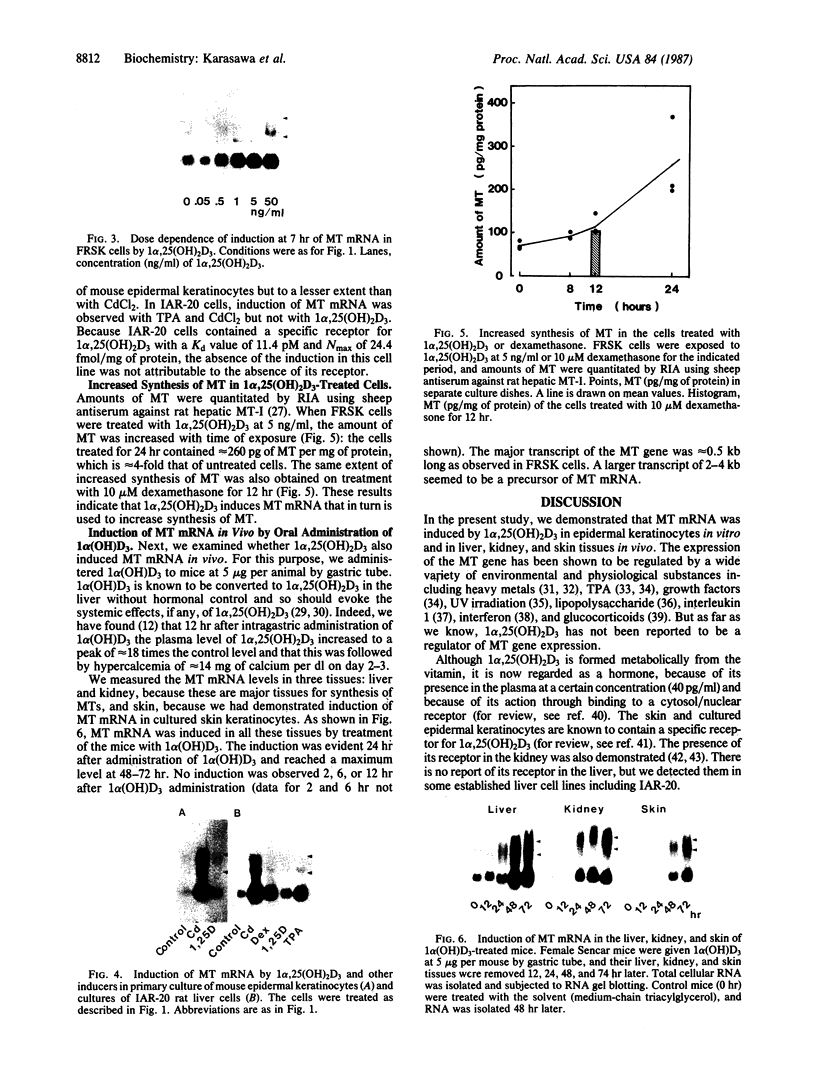
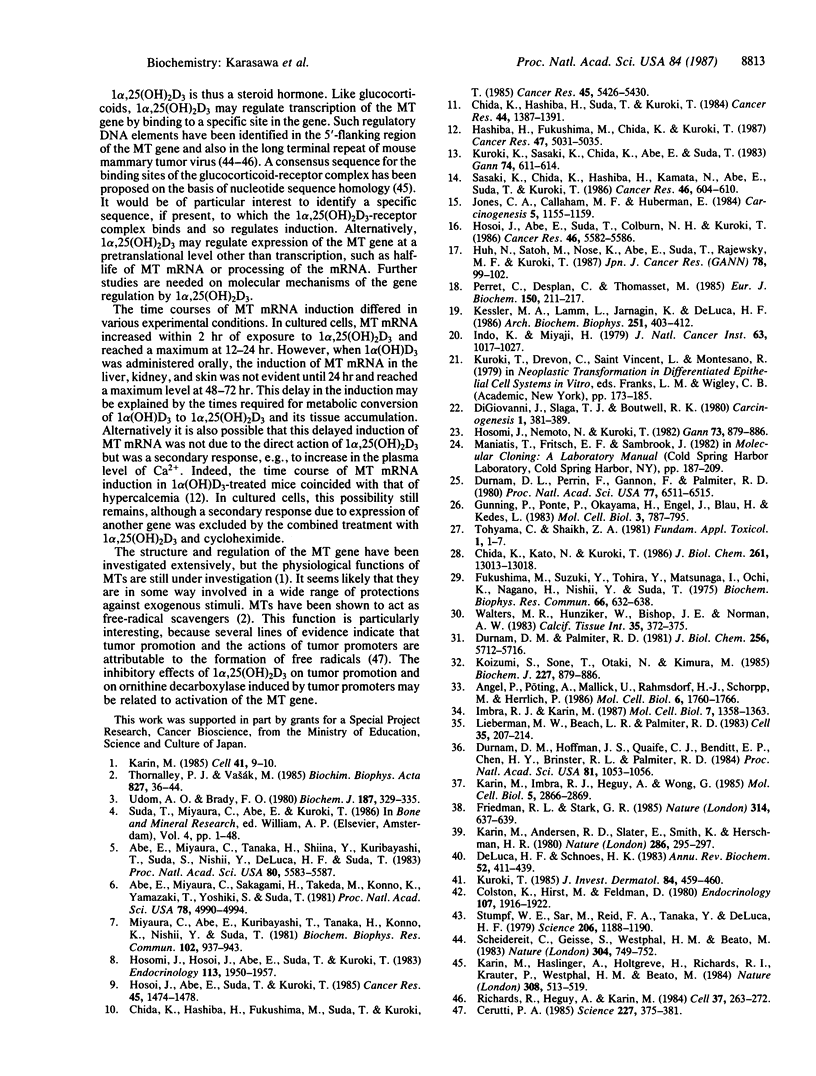
Images in this article
Selected References
These references are in PubMed. This may not be the complete list of references from this article.
- Abe E., Miyaura C., Sakagami H., Takeda M., Konno K., Yamazaki T., Yoshiki S., Suda T. Differentiation of mouse myeloid leukemia cells induced by 1 alpha,25-dihydroxyvitamin D3. Proc Natl Acad Sci U S A. 1981 Aug;78(8):4990–4994. doi: 10.1073/pnas.78.8.4990. [DOI] [PMC free article] [PubMed] [Google Scholar]
- Abe E., Miyaura C., Tanaka H., Shiina Y., Kuribayashi T., Suda S., Nishii Y., DeLuca H. F., Suda T. 1 alpha,25-dihydroxyvitamin D3 promotes fusion of mouse alveolar macrophages both by a direct mechanism and by a spleen cell-mediated indirect mechanism. Proc Natl Acad Sci U S A. 1983 Sep;80(18):5583–5587. doi: 10.1073/pnas.80.18.5583. [DOI] [PMC free article] [PubMed] [Google Scholar]
- Angel P., Pöting A., Mallick U., Rahmsdorf H. J., Schorpp M., Herrlich P. Induction of metallothionein and other mRNA species by carcinogens and tumor promoters in primary human skin fibroblasts. Mol Cell Biol. 1986 May;6(5):1760–1766. doi: 10.1128/mcb.6.5.1760. [DOI] [PMC free article] [PubMed] [Google Scholar]
- Cerutti P. A. Prooxidant states and tumor promotion. Science. 1985 Jan 25;227(4685):375–381. doi: 10.1126/science.2981433. [DOI] [PubMed] [Google Scholar]
- Chida K., Hashiba H., Fukushima M., Suda T., Kuroki T. Inhibition of tumor promotion in mouse skin by 1 alpha,25-dihydroxyvitamin D3. Cancer Res. 1985 Nov;45(11 Pt 1):5426–5430. [PubMed] [Google Scholar]
- Chida K., Hashiba H., Suda T., Kuroki T. Inhibition by 1 alpha, 25-dihydroxyvitamin D3 of induction of epidermal ornithine decarboxylase caused by 12-O-tetradecanoylphorbol-13-acetate and teleocidin B. Cancer Res. 1984 Apr;44(4):1387–1391. [PubMed] [Google Scholar]
- Chida K., Kato N., Kuroki T. Down regulation of phorbol diester receptors by proteolytic degradation of protein kinase C in a cultured cell line of fetal rat skin keratinocytes. J Biol Chem. 1986 Oct 5;261(28):13013–13018. [PubMed] [Google Scholar]
- Colston K., Hirt M., Feldman D. Organ distribution of the cytoplasmic 1,25-dihydroxycholecalciferol receptor in various mouse tissues. Endocrinology. 1980 Dec;107(6):1916–1922. doi: 10.1210/endo-107-6-1916. [DOI] [PubMed] [Google Scholar]
- DeLuca H. F., Schnoes H. K. Vitamin D: recent advances. Annu Rev Biochem. 1983;52:411–439. doi: 10.1146/annurev.bi.52.070183.002211. [DOI] [PubMed] [Google Scholar]
- DiGiovanni J., Slaga T. J., Boutwell R. K. Comparison of the tumor-initiating activity of 7,12-dimethylbenz[a]anthracene and benzo[a]pyrene in female SENCAR and CS-1 mice. Carcinogenesis. 1980 May;1(5):381–389. doi: 10.1093/carcin/1.5.381. [DOI] [PubMed] [Google Scholar]
- Durnam D. M., Hoffman J. S., Quaife C. J., Benditt E. P., Chen H. Y., Brinster R. L., Palmiter R. D. Induction of mouse metallothionein-I mRNA by bacterial endotoxin is independent of metals and glucocorticoid hormones. Proc Natl Acad Sci U S A. 1984 Feb;81(4):1053–1056. doi: 10.1073/pnas.81.4.1053. [DOI] [PMC free article] [PubMed] [Google Scholar]
- Durnam D. M., Palmiter R. D. Transcriptional regulation of the mouse metallothionein-I gene by heavy metals. J Biol Chem. 1981 Jun 10;256(11):5712–5716. [PubMed] [Google Scholar]
- Durnam D. M., Perrin F., Gannon F., Palmiter R. D. Isolation and characterization of the mouse metallothionein-I gene. Proc Natl Acad Sci U S A. 1980 Nov;77(11):6511–6515. doi: 10.1073/pnas.77.11.6511. [DOI] [PMC free article] [PubMed] [Google Scholar]
- Friedman R. L., Stark G. R. alpha-Interferon-induced transcription of HLA and metallothionein genes containing homologous upstream sequences. Nature. 1985 Apr 18;314(6012):637–639. doi: 10.1038/314637a0. [DOI] [PubMed] [Google Scholar]
- Fukushima M., Suzuki Y., Toira Y., Matsunaga I., Ochi K., Nagano H. Metabolism of 1alpha-hydroxyvitamin D3 to 1alpha, 25-dihydroxyvitamin D3 in perfused rat liver. Biochem Biophys Res Commun. 1975 Sep 16;66(2):632–638. doi: 10.1016/0006-291x(75)90556-2. [DOI] [PubMed] [Google Scholar]
- Gunning P., Ponte P., Okayama H., Engel J., Blau H., Kedes L. Isolation and characterization of full-length cDNA clones for human alpha-, beta-, and gamma-actin mRNAs: skeletal but not cytoplasmic actins have an amino-terminal cysteine that is subsequently removed. Mol Cell Biol. 1983 May;3(5):787–795. doi: 10.1128/mcb.3.5.787. [DOI] [PMC free article] [PubMed] [Google Scholar]
- Hashiba H., Fukushima M., Chida K., Kuroki T. Systemic inhibition of tumor promoter-induced ornithine decarboxylase in 1 alpha-hydroxyvitamin D3-treated animals. Cancer Res. 1987 Oct 1;47(19):5031–5035. [PubMed] [Google Scholar]
- Hosoi J., Abe E., Suda T., Colburn N. H., Kuroki T. Induction of anchorage-independent growth of JB6 mouse epidermal cells by 1 alpha,25-dihydroxyvitamin D3. Cancer Res. 1986 Nov;46(11):5582–5586. [PubMed] [Google Scholar]
- Hosoi J., Abe E., Suda T., Kuroki T. Regulation of melanin synthesis of B16 mouse melanoma cells by 1 alpha, 25-dihydroxyvitamin D3 and retinoic acid. Cancer Res. 1985 Apr;45(4):1474–1478. [PubMed] [Google Scholar]
- Hosomi J., Hosoi J., Abe E., Suda T., Kuroki T. Regulation of terminal differentiation of cultured mouse epidermal cells by 1 alpha,25-dihydroxyvitamin D3. Endocrinology. 1983 Dec;113(6):1950–1957. doi: 10.1210/endo-113-6-1950. [DOI] [PubMed] [Google Scholar]
- Hosomi J., Nemoto N., Kuroki T. Metabolism of benzo[a]pyrene and other carcinogens in mouse epidermal keratinocytes in culture. Gan. 1982 Dec;73(6):879–886. [PubMed] [Google Scholar]
- Huh N., Satoh M., Nose K., Abe E., Suda T., Rajewsky M. F., Kuroki T. 1 alpha,25-Dihydroxyvitamin D3 induces anchorage-independent growth and c-Ki-ras expression of BALB/3T3 and NIH/3T3 cells. Jpn J Cancer Res. 1987 Feb;78(2):99–102. [PubMed] [Google Scholar]
- Imbra R. J., Karin M. Metallothionein gene expression is regulated by serum factors and activators of protein kinase C. Mol Cell Biol. 1987 Apr;7(4):1358–1363. doi: 10.1128/mcb.7.4.1358. [DOI] [PMC free article] [PubMed] [Google Scholar]
- Indo K., Miyaji H. Qualitative changes in the biologic characteristics of cultured fetal rat keratinizing epidermal cells during the process of malignant transformation after benzo[a]pyrene treatment. J Natl Cancer Inst. 1979 Oct;63(4):1017–1027. [PubMed] [Google Scholar]
- Jones C. A., Callaham M. F., Huberman E. Enhancement of chemical-carcinogen-induced cell transformation in hamster embryo cells by 1 alpha,25-dihydroxycholecalciferol, the biologically active metabolite of vitamin D3. Carcinogenesis. 1984 Sep;5(9):1155–1159. doi: 10.1093/carcin/5.9.1155. [DOI] [PubMed] [Google Scholar]
- Karin M., Andersen R. D., Slater E., Smith K., Herschman H. R. Metallothionein mRNA induction in HeLa cells in response to zinc or dexamethasone is a primary induction response. Nature. 1980 Jul 17;286(5770):295–297. doi: 10.1038/286295a0. [DOI] [PubMed] [Google Scholar]
- Karin M., Haslinger A., Holtgreve H., Richards R. I., Krauter P., Westphal H. M., Beato M. Characterization of DNA sequences through which cadmium and glucocorticoid hormones induce human metallothionein-IIA gene. Nature. 1984 Apr 5;308(5959):513–519. doi: 10.1038/308513a0. [DOI] [PubMed] [Google Scholar]
- Karin M., Imbra R. J., Heguy A., Wong G. Interleukin 1 regulates human metallothionein gene expression. Mol Cell Biol. 1985 Oct;5(10):2866–2869. doi: 10.1128/mcb.5.10.2866. [DOI] [PMC free article] [PubMed] [Google Scholar]
- Karin M. Metallothioneins: proteins in search of function. Cell. 1985 May;41(1):9–10. doi: 10.1016/0092-8674(85)90051-0. [DOI] [PubMed] [Google Scholar]
- Kessler M. A., Lamm L., Jarnagin K., DeLuca H. F. 1,25-Dihydroxyvitamin D3-stimulated mRNAs in rat small intestine. Arch Biochem Biophys. 1986 Dec;251(2):403–412. doi: 10.1016/0003-9861(86)90346-2. [DOI] [PubMed] [Google Scholar]
- Koizumi S., Sone T., Otaki N., Kimura M. Cd2+-induced synthesis of metallothionein in HeLa cells. Biochem J. 1985 May 1;227(3):879–886. doi: 10.1042/bj2270879. [DOI] [PMC free article] [PubMed] [Google Scholar]
- Kuroki T. Possible functions of 1 alpha,25-dihydroxyvitamin D3, an active form of vitamin D3, in the differentiation and development of skin. J Invest Dermatol. 1985 Jun;84(6):459–460. doi: 10.1111/1523-1747.ep12272331. [DOI] [PubMed] [Google Scholar]
- Kuroki T., Sasaki K., Chida K., Abe E., Suda T. 1 alpha,25-Dihydroxyvitamin D3 markedly enhances chemically-induced transformation in BALB 3T3 cells. Gan. 1983 Oct;74(5):611–614. [PubMed] [Google Scholar]
- Lieberman M. W., Beach L. R., Palmiter R. D. Ultraviolet radiation-induced metallothionein-I gene activation is associated with extensive DNA demethylation. Cell. 1983 Nov;35(1):207–214. doi: 10.1016/0092-8674(83)90223-4. [DOI] [PubMed] [Google Scholar]
- Miyaura C., Abe E., Kuribayashi T., Tanaka H., Konno K., Nishii Y., Suda T. 1 alpha,25-Dihydroxyvitamin D3 induces differentiation of human myeloid leukemia cells. Biochem Biophys Res Commun. 1981 Oct 15;102(3):937–943. doi: 10.1016/0006-291x(81)91628-4. [DOI] [PubMed] [Google Scholar]
- Perret C., Desplan C., Thomasset M. Cholecalcin (a 9-kDa cholecalciferol-induced calcium-binding protein) messenger RNA. Distribution and induction by calcitriol in the rat digestive tract. Eur J Biochem. 1985 Jul 1;150(1):211–217. doi: 10.1111/j.1432-1033.1985.tb09009.x. [DOI] [PubMed] [Google Scholar]
- Richards R. I., Heguy A., Karin M. Structural and functional analysis of the human metallothionein-IA gene: differential induction by metal ions and glucocorticoids. Cell. 1984 May;37(1):263–272. doi: 10.1016/0092-8674(84)90322-2. [DOI] [PubMed] [Google Scholar]
- Sasaki K., Chida K., Hashiba H., Kamata N., Abe E., Suda T., Kuroki T. Enhancement by 1 alpha,25-dihydroxyvitamin D3 of chemically induced transformation of BALB 3T3 cells without induction of ornithine decarboxylase or activation of protein kinase C1. Cancer Res. 1986 Feb;46(2):604–610. [PubMed] [Google Scholar]
- Scheidereit C., Geisse S., Westphal H. M., Beato M. The glucocorticoid receptor binds to defined nucleotide sequences near the promoter of mouse mammary tumour virus. Nature. 1983 Aug 25;304(5928):749–752. doi: 10.1038/304749a0. [DOI] [PubMed] [Google Scholar]
- Stumpf W. E., Sar M., Reid F. A., Tanaka Y., DeLuca H. F. Target cells for 1,25-dihydroxyvitamin D3 in intestinal tract, stomach, kidney, skin, pituitary, and parathyroid. Science. 1979 Dec 7;206(4423):1188–1190. doi: 10.1126/science.505004. [DOI] [PubMed] [Google Scholar]
- Thornalley P. J., Vasák M. Possible role for metallothionein in protection against radiation-induced oxidative stress. Kinetics and mechanism of its reaction with superoxide and hydroxyl radicals. Biochim Biophys Acta. 1985 Jan 21;827(1):36–44. doi: 10.1016/0167-4838(85)90098-6. [DOI] [PubMed] [Google Scholar]
- Tohyama C., Shaikh Z. A. Metallothionein in plasma and urine of cadmium-exposed rats determined by a single-antibody radioimmunoassay. Fundam Appl Toxicol. 1981 Jan-Feb;1(1):1–7. doi: 10.1093/toxsci/1.1.1-c. [DOI] [PubMed] [Google Scholar]
- Udom A. O., Brady F. O. Reactivation in vitro of zinc-requiring apo-enzymes by rat liver zinc-thionein. Biochem J. 1980 May 1;187(2):329–335. doi: 10.1042/bj1870329. [DOI] [PMC free article] [PubMed] [Google Scholar]
- Walters M. R., Hunziker W., Bishop J. E., Norman A. W. Studies on the mode of action of vitamin D XXXVII 1 alpha-hydroxyvitamin D3: a long-acting 1,25-dihydroxyvitamin D3 analog. Calcif Tissue Int. 1983 May;35(3):372–375. doi: 10.1007/BF02405061. [DOI] [PubMed] [Google Scholar]





